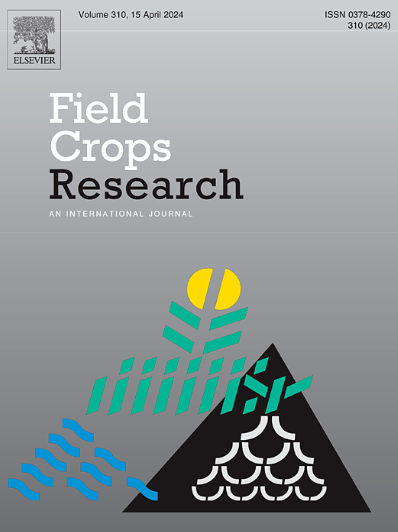Grazing management of cultivated grassland with different weed proportions optimizes soil nutrient status and improves forage yield and nutritional quality
IF 6.4
1区 农林科学
Q1 AGRONOMY
引用次数: 0
Abstract
Context
Grassland utilization methods and weed management are critical strategies for optimizing soil ecology and sustainable forage productivity in cultivated grasslands. However, the mechanisms by which grazing/mowing and weed proportions influence forage productivity, soil nutrient cycling, and ecosystem stability through interspecific complementarity and competition are not well understood, particularly in arid agroecosystems with interannual climate variability. To address this, a three-year field experiment was conducted in the arid inland region of Northwest China to evaluate the effects of different grassland utilization methods and weed-to-forage ratios on soil nutrients, forage yield, and nutritional quality in two mixed cultivated grasslands.
Methods
A three-year field experiment was conducted in the arid inland region of Northwest China, including two grassland utilizations (grazing and mowing), three weed ratios (weed biomass: forage biomass = 4: 6, 2: 8, 0: 10) for two mixed cultivated grasslands (Medicago sativa +Bromus inermis, Festuca arundinacea + Bromus inermis), to evaluate their effects on the soil nutrients, productivity and nutritional quality of cultivated grasslands. Key plant physiological and soil biochemical indicators were measured, including yield composition, crude protein, ether extract, soil available potassium, alkali-hydrolyzable nitrogen, urease and alkaline phosphatase activities.
Results
The results showed a 6.28 %-36.14 % higher forage yield in grazing grassland than mowing grassland. The forage yield decreased with the increase in weed proportion. Moreover, the yield stability of Festuca arundinacea + Bromus inermis grassland was better than that of Medicago sativa + Bromus inermis grassland. The crude protein and ether extract contents of Medicago sativa, Festuca arundinacea and Bromus inermis in mixed cultivation grassland decreased with the increase in weed proportion. Grazing significantly increased the crude protein and ether extract contents of the pastures. Soil available potassium and alkali-hydrolyzable nitrogen in the surface layer (0–10 cm) were significantly higher in grazing grassland than mowing grassland. In 2024, the activities of urease and alkaline phosphatase in grazing grassland were higher by 26.77 %-95.80 % and 6.72 %-33.46 % than mowing grassland, respectively. Correlation analysis revealed negative relationship of forage yield and crude protein content with acid detergent fiber and neutral detergent fiber, while positive correlation between yield and crude protein content. In addition, urease was positively correlated with temperature and rainfall.
Conclusion
Overall, grassland utilization through grazing and maintaining a lower weed to pasture ratio enhances soil nutrients, forage yield, and nutritional quality. This research establishes a scientific foundation for efficient management of cultivated grasslands, improving productivity and optimizing soil nutrient dynamics in arid regions.
不同杂草比例栽培草地的放牧管理优化了土壤养分状况,提高了牧草产量和营养品质
草地利用方式和杂草管理是优化耕地草地土壤生态和实现牧草可持续生产的关键策略。然而,放牧/刈割和杂草比例通过种间互补和竞争影响牧草生产力、土壤养分循环和生态系统稳定性的机制尚不清楚,特别是在年际气候变化的干旱农业生态系统中。为了解决这一问题,在西北干旱内陆地区进行了为期3年的田间试验,评估了不同草地利用方式和草料比对两种混合栽培草地土壤养分、牧草产量和营养品质的影响。方法在西北干旱内陆地区进行为期3年的田间试验,采用两种草地利用方式(放牧和刈割)、三种杂草比例(杂草生物量:牧草生物量= 4:6、2:8、0:10)对两种混合栽培草地(紫花苜蓿+雀稗、黄羊茅+雀稗)土壤养分、生产力和营养质量的影响进行评价。测定了产量组成、粗蛋白质、粗脂肪、土壤速效钾、碱解氮、脲酶和碱性磷酸酶活性等主要植物生理和土壤生化指标。结果放牧草地牧草产量比刈割草地高6.28 % ~ 36.14 %。牧草产量随杂草比例的增加而降低。此外,黄羊茅+ 雀稗草地的产量稳定性优于苜蓿+ 雀稗草地。混耕草地苜蓿、羊茅和雀稗粗蛋白质和粗脂肪含量随杂草比例的增加而降低。放牧显著提高了牧草粗蛋白质和粗脂肪含量。放牧草地表层(0 ~ 10 cm)土壤速效钾和碱解氮含量显著高于刈割草地。2024年,放牧草地脲酶和碱性磷酸酶活性分别比刈割草地高26.77 % ~ 95.80 %和6.72 % ~ 33.46 %。相关分析表明,酸性洗涤纤维和中性洗涤纤维与产量和粗蛋白质含量呈负相关,与产量和粗蛋白质含量呈正相关。脲酶与温度、降雨量呈显著正相关。结论总体而言,通过放牧和保持较低草草比的草地利用可以提高土壤养分、牧草产量和营养品质。本研究为干旱区草地的高效管理、生产力的提高和土壤养分动态的优化提供了科学依据。
本文章由计算机程序翻译,如有差异,请以英文原文为准。
求助全文
约1分钟内获得全文
求助全文
来源期刊

Field Crops Research
农林科学-农艺学
CiteScore
9.60
自引率
12.10%
发文量
307
审稿时长
46 days
期刊介绍:
Field Crops Research is an international journal publishing scientific articles on:
√ experimental and modelling research at field, farm and landscape levels
on temperate and tropical crops and cropping systems,
with a focus on crop ecology and physiology, agronomy, and plant genetics and breeding.
 求助内容:
求助内容: 应助结果提醒方式:
应助结果提醒方式:


